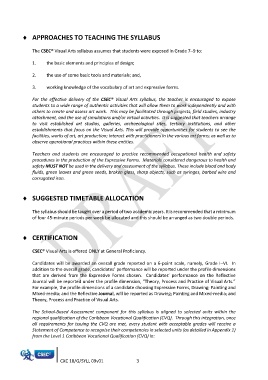Page 1404 - SUBSEC October 2017_Neat
P. 1404
APPROACHES TO TEACHING THE SYLLABUS
The CSEC® Visual Arts syllabus assumes that students were exposed in Grade 7–9 to:
1. the basic elements and principles of design;
2. the use of some basic tools and materials; and,
3. working knowledge of the vocabulary of art and expressive forms.
For the effective delivery of the CSEC® Visual Arts syllabus, the teacher is encouraged to expose
students to a wide range of authentic activities that will allow them to work independently and with
others to create and assess art work. This may be facilitated through projects, field studies, industry
attachment, and the use of simulations and/or virtual activities. It is suggested that teachers arrange
to visit established art studios, galleries, archaeological sites, tertiary institutions, and other
establishments that focus on the Visual Arts. This will provide opportunities for students to see the
facilities, works of art, art production; interact with practitioners in the various art forms; as well as to
observe operational practices within these entities.
Teachers and students are encouraged to practice recommended occupational health and safety
procedures in the production of the Expressive Forms. Materials considered dangerous to health and
safety MUST NOT be used in the delivery and assessment of the syllabus. These include blood and body
fluids, green leaves and green seeds, broken glass, sharp objects, such as syringes, barbed wire and
corrugated iron.
SUGGESTED TIMETABLE ALLOCATION
The syllabus should be taught over a period of two academic years. It is recommended that a minimum
of four 45-minute periods per week be allocated and this should be arranged as two double periods.
CERTIFICATION
CSEC® Visual Arts is offered ONLY at General Proficiency.
Candidates will be awarded an overall grade reported on a 6-point scale, namely, Grade I–VI. In
addition to the overall grade, candidates’ performance will be reported under the profile dimensions
that are derived from the Expressive Forms chosen. Candidates’ performance on the Reflective
Journal will be reported under the profile dimension, “Theory, Process and Practice of Visual Arts.”
For example, the profile dimensions of a candidate choosing Expressive Forms, Drawing; Painting and
Mixed-media; and the Reflective Journal, will be reported as Drawing; Painting and Mixed-media; and
Theory, Process and Practice of Visual Arts.
The School-Based Assessment component for this syllabus is aligned to selected units within the
regional qualification of the Caribbean Vocational Qualification (CVQ). Through this integration, once
all requirements for issuing the CVQ are met, every student with acceptable grades will receive a
Statement of Competence to recognise their competencies in selected units (as detailed in Appendix 1)
from the Level 1 Caribbean Vocational Qualification (CVQ) in:
CXC 18/G/SYLL 09v01 3

